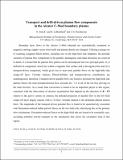| dc.contributor.author | Smick, N. | |
| dc.contributor.author | Labombard, Brian | |
| dc.contributor.author | Hutchinson, Ian Horner | |
| dc.date.accessioned | 2014-01-17T16:18:51Z | |
| dc.date.available | 2014-01-17T16:18:51Z | |
| dc.date.issued | 2013-01 | |
| dc.date.submitted | 2012-08 | |
| dc.identifier.issn | 0029-5515 | |
| dc.identifier.issn | 1741-4326 | |
| dc.identifier.uri | http://hdl.handle.net/1721.1/84061 | |
| dc.description.abstract | Boundary layer flows in the Alcator C-Mod tokamak are systematically examined as magnetic topology (upper versus lower-null) and plasma density are changed. Utilizing a unique set of scanning Langmuir–Mach probes, including one on the high-field side (HFS) midplane, the poloidal variation of plasma flow components in the parallel, diamagnetic and radial directions are resolved in detail. It is found that the plasma flow pattern can be decomposed into two principal parts: (1) a drift-driven component, which lies within a magnetic flux surface and is divergence-free and (2) a transport-driven component, which gives rise to near-sonic parallel flows on the HFS scrape-off layer (SOL). Toroidal rotation, Pfirsch–Schlüter and transport-driven contributions are unambiguously identified. Transport-driven parallel flows are found to dominate the HFS particle fluxes; the total poloidal-directed flow accounts for ~1/3 to all of the ion flux arriving on the inner divertor. As a result, heat convection is found to be an important player in this region, consistent with the observation of divertor asymmetries that depend on the direction of B × ∇B relative to the active x-point. In contrast, the poloidal projection of parallel flow in the low-field SOL largely cancels with E[subscript r] × B flow; toroidal rotation is the dominant plasma motion there. The magnitude of the transport-driven poloidal flow is found to be quantitatively consistent with fluctuation-induced radial particle fluxes on the low-field side (LFS), identifying this as the primary drive mechanism. Fluctuation-induced fluxes on the HFS are found to be essentially zero, excluding turbulent inward transport as the mechanism that closes the circulation loop in this region. | en_US |
| dc.description.sponsorship | United States. Dept. of Energy (Cooperative Agreement DE-FC02-99ER54512) | en_US |
| dc.language.iso | en_US | |
| dc.publisher | IOP Publishing | en_US |
| dc.relation.isversionof | http://dx.doi.org/10.1088/0029-5515/53/2/023001 | en_US |
| dc.rights | Creative Commons Attribution-Noncommercial-Share Alike 3.0 | en_US |
| dc.rights.uri | http://creativecommons.org/licenses/by-nc-sa/3.0/ | en_US |
| dc.source | Prof. Hutchinson via Chris Sherratt | en_US |
| dc.title | Transport and drift-driven plasma flow components in the Alcator C-Mod boundary plasma | en_US |
| dc.type | Article | en_US |
| dc.identifier.citation | Smick, N., B. LaBombard, and I.H. Hutchinson. “Transport and drift-driven plasma flow components in the Alcator C-Mod boundary plasma.” Nuclear Fusion 53, no. 2 (February 1, 2013): 023001. | en_US |
| dc.contributor.department | Massachusetts Institute of Technology. Department of Nuclear Science and Engineering | en_US |
| dc.contributor.department | Massachusetts Institute of Technology. Plasma Science and Fusion Center | en_US |
| dc.contributor.approver | Hutchinson, Ian | en_US |
| dc.contributor.mitauthor | Smick, N. | en_US |
| dc.contributor.mitauthor | Labombard, Brian | en_US |
| dc.contributor.mitauthor | Hutchinson, Ian H. | en_US |
| dc.relation.journal | Nuclear Fusion | en_US |
| dc.eprint.version | Author's final manuscript | en_US |
| dc.type.uri | http://purl.org/eprint/type/JournalArticle | en_US |
| eprint.status | http://purl.org/eprint/status/PeerReviewed | en_US |
| dspace.orderedauthors | Smick, N.; LaBombard, B.; Hutchinson, I.H. | en_US |
| dc.identifier.orcid | https://orcid.org/0000-0002-7841-9261 | |
| mit.license | OPEN_ACCESS_POLICY | en_US |
| mit.metadata.status | Complete | |
